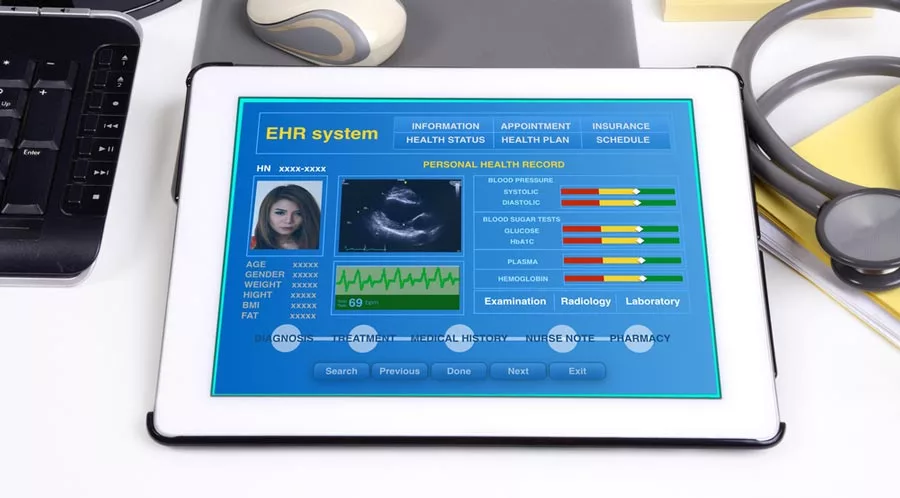Medical Billing Software for Substance Abuse Treatment Centers
When designing substance abuse EMR software, vendors must keep in mind the unique needs of individual addiction treatment centers. Because no two substance abuse treatment centers are created equal, the same should hold true for substance abuse EMR software.
In this article, we cover the different types of substance abuse EHR and medical record software, in addition to EMR products. We’ll also help you understand the best way to choose the most appropriate substance abuse software for your organization.
What Is Substance Abuse EHR Software?
Electronic Health Record (EHR) software helps to streamline the clinical workflow process, including lab, diagnostic, and pharmaceutical equipment integration. This helps track client progress and report how effective individual treatment plans are for each client.
EHR software for substance abuse clinics is more comprehensive than EMR (Electronic Medical Record) software. When facilities use EHR, it’s more for the overall practice management of a substance abuse treatment center. This includes electronic prescription writing and tracking, lab orders, and entire telehealth applications and systems.
What Is Substance Abuse EMR Software?
Where EHR is for practice management, EMR (Electronic Medical Record) is centered around client or patient management. Essentially, EMR software is the digital version of a patient chart and includes vital information regarding a client’s personalized treatment plan.
Specific Differences Between EMR and EHR for Addiction Medicine

Substance abuse centers must also understand the difference between an EMR and EHR and how they relate to one another concerning addiction medicine. EMR software is designed for the current client situation and deals with the immediate future, helping doctors and counselors to track the progress of an individual treatment plan.
Who Are They For?
Typically you will notice that most EHR software is designed for broad use and is shared among multiple facilities and organizations. Essentially, this could be looked at as a permanent medical history for a client that tracks a much larger scope of their treatment history.
EMR information, on the other hand, is almost always limited solely to the specific treatment facility in that one is enrolled. The facility in question only shares these records among counselors and doctors at that specific facility to make immediate decisions and track recent procedures, medications, and therapy sessions.
What these electronic medical records do for addiction medicine is incredibly efficient, forming integrated practice management that makes almost every element of your organization and client profile accessible from one convenient dashboard.
Like with any other newly adopted program or technology, both of these methods of record-keeping come with their advantages and disadvantages.
What are the Pros and Cons of Addiction Medicine Software?
Pros
- Creates an all-inclusive record-keeping system to track every facet of the client experience and working arm of your organization.
- Streamlines all of your workflows to make data logging quicker and more convenient.
- Records are easily backed up to multiple locations to keep them safe in the event of a disaster.
- Data can be plugged into other medical and addiction-related app technology to help further optimize the treatment process using AI and smart technology.
Cons
- Depending on the programs you select, the investment can be quite high.
- Like with any new system, there is a learning curve, and you may experience a more difficult time initially until everyone adopts the new system.
What’s Included in Substance Abuse EMR Software?

Regardless of the specific software you select, there are certain elements you can expect as inclusions after deploying your new records system.
In this section, we highlight the most commonly included features of addiction medicine software, whether to meet the requirements for admission according to the American Society of Addiction Medicine (ASAM criteria) or otherwise.
Templates
A plethora of templates exists on nearly every software regardless of the maker. Templates drastically cut down the time you must spend labeling and notating during sessions with clients. This makes the charting process much easier for each individual. Templates range from drug addiction, alcoholism, opioids, and infection risk/management.
Manage Reimbursement
Certain treatment centers bill insurance companies, some charge clients directly, while others attempt to secure funds from grants and charities. Regarding insurance billing, any record-keeping system includes codes to accurately note all claims.
Your EHR software should simplify the insurance billing procedures of your organization, in addition to streamlining any reimbursements for grants, charities, and client donations.
Managing Your Workflow
A robust software simplifies your workflow overall and follows the client experience from the initial call to discharge and even aftercare.
Scheduling
Substance abuse treatment clinics must maintain a tightly packed schedule. Certain therapy sessions are conducted in a one-on-one environment while some are group-oriented. Any software you’re using should have advanced scheduling options, allowing you to schedule multiple clients at once. Your software should also allow your outpatient and even virtual IOP clients to book sessions on your website.
Document Management
Therapists, doctors, nurses, and counselors must be able to refer back to old notes during current sessions. There are many occasions when they require access to multiple client records, as referenced by the above example and group therapy environments.
Your EHR software must handle a large volume of documents while providing easy access to individual and multiple documents at once. Newer software leverages the power of AI to chart clients rather than using multiple models and templates.
Document management is also important from a privacy standpoint, and the right software ensures the safe handling of sensitive client information.
Integration
Tracking progress and individual treatment plans requires staff to be aware of the history of every client enrolled at your facility. EMR software should have integration options with diagnostic equipment, pharmacies, and laboratories, in addition to a secure messaging platform that allows real-time communication between physicians and counselors.
In some cases, billing and coding integrations with public or private charities are also integrated when desired by treatment centers that work with frequently with these organizations.
Managing Medication
Your substance abuse EMR software should include workflows that help manage client prescriptions, helping to improve safety, optimize treatment plans, and remain aligned with regulatory compliance.
Important Things to Remember Regarding Substance Abuse Software

Substance abuse software brings multiple benefits to any organization. We touched on the surface of these benefits earlier – let’s dive in a little deeper regarding what the right EHR system can do for your facility.
Treatment centers that have transitioned to electronic software for record-keeping and workflows have experienced the following changes:
Improved Efficiency of Their Staff and Treatment Center
Improved efficiency in multiple areas is one of the first and most noticeable benefits of adopting this software. Quicker and easier record-keeping, simpler workflows, and more efficient tracking of data are all included as some of the most significant advantages.
More Profitability
Because efficiency increases, it’s only natural that revenue follows in the heels of these increases. Improved workflows equate to fewer mistakes, fewer hours, and the ability to cut costs in areas that may have previously gone unnoticed.
Client Engagement
Perhaps the most beneficial area after deploying electronic record-keeping software is an increase in client engagement. When counselors and doctors spend less time fumbling with paperwork and have more efficient ways of tracking data along with individual treatment plans, clients likely notice the positive changes as well.
This leads them to gain more confidence in the process, in turn causing them to open up more and display higher participation levels in group and one-on-one counseling.
Decreased Supply Costs
This is a simple, almost forgotten benefit. Decreased supply costs can make a drastic impact on the budget of any facility. Less money spent on paper, pens, and other utensils can leave a noticeable mark at the end of the quarter.
Better Care Coordination
When different members of a client treatment team can coordinate and work more collaboratively, this leads to better care for each client in the end. From documenting and sharing data to communicating in real-time, better care coordination is one of the most powerful results of having this clinical data.
Enhanced Safety and Security
Network and security experts are on the job around the clock for these software companies. In addition, data and information stored in the cloud are not only backed up but also extremely secure.
What You Should Look for In Your Substance Abuse Management Software

Now that you have a better understanding of substance abuse electronic record management, what should you look for in the specific software you select? Substance abuse treatment center management should be mindful of the following inclusions:
- Specifically aimed at substance abuse treatment centers. The software you select should be specifically crafted for rehabs. Because of similar functions, it’s easy to get confused or select software that isn’t optimized for your facility.
- Integration. Because rehabs have so many working arms and different departments, in addition to frequently working with outside and third-party agencies, integration is critical. The software should securely manage patient data while still helping to enable healthcare providers across multiple facilities to collaborate for a better client experience.
Things like the ability to manage patient medication in-house are important, but mediation management can sometimes stretch between multiple providers – this is where integration for multiple patients comes into play.
- Practice management. Besides client management, find software that includes practice management. This includes additional elements related to your facility that don’t include client care and relations. Things like regulatory compliance tracking, inventory management, certifications, and other practice management features are important for any EMR software for substance abuse rehabs.
- Medical Billing. Your substance abuse EMR software should also include features for medical billing or an affilited service. This is one of the most important workflows for any substance abuse electronic health records software, and one of the most time-consuming when performed manually. This should be one of the primary things to check for when looking for EMR software.
- Medication Management. This is vital, especially if your facility includes medically-assisted detox. Clinical documentation across multiple patient records for medication regimens is critical in electronic health records software that’s deployed for facilities with medication-assisted treatment as well.
Electronic Medical Records Systems and Cloud Based EMR Software
At Ads Up Marketing, we can help you find the most appropriate EMR provider, and even help you deploy your system and demonstrate how these systems operate with regard to your advertising and content management.
For more information on this and other services we offer, contact us via phone or website and let’s set up a meeting.
Free Digital Marketing Analysis




